
About UsThe Numismatic Bibliomania Society is a non-profit organization promoting numismatic literature. For more information please see our web site at coinbooks.org SubscriptionsThose wishing to become new E-Sylum subscribers (or wishing to Unsubscribe) can go to the following web page link MembershipThere is a membership application available on the web site Membership Application To join, print the application and return it with your check to the address printed on the application. Membership is only $15 to addresses in the U.S., $20 for First Class mail, and $25 elsewhere. For those without web access, write to: David M. Sundman, Secretary/TreasurerNumismatic Bibliomania
Society AsylumFor Asylum mailing address changes and other membership questions, contact David at this email address: dsundman@LittletonCoin.com SubmissionsTo submit items for publication in The E-Sylum, just Reply to this message, or write to the Editor at this address: whomren@coinlibrary.com
BUY THE BOOK BEFORE THE COINYou won't regret it! |
- WAYNE'S WORDS: THE E-SYLUM JANUARY 31, 2010
- FANNING NUMISMATIC LITERATURE FIXED PRICE CATALOGUE AVAILABLE
- SKLOW NUMISMATIC LITERATURE MAIL BID SALE #9 CLOSES FEBRUARY 13, 2010
- NEW BOOK: STRIKING GOLD IN ALASKA BY DICK HANSCOM
- NEW CD BOOK: CHATTANOOGA MONEY BY DENNIS SCHAFLUETZEL
- BOOK REVIEW: STRIKE IT RICH WITH POCKET CHANGE, SECOND EDITION
- ORDERING THE NEW YORK NUMISMATIC CLUB CENTENNIAL HISTORY
- ANS LIBRARY CATALOG NAMING CONTEST DEADLINE FEBRUARY 15, 2010
- FOOD STAMPS AS MONEY
- MORE ON THE SPENDING PSYCHOLOGY OF MONEY DENOMINATIONS
- QUERY: SPANISH-AMERICAN EIGHT REALES METROLOGICAL DATA SOUGHT
- MORE ON CENTRAL INTELLIGENCE AGENCY MEDALS
- COINTELEVISION.COM COVERS THE 2010 F.U.N. SHOW
- CANADIAN COLLECTOR'S COINS TELL A STORY
- HIGH QUALITY COUNTERFEIT BANKNOTES FOUND IN JAPAN
- VERDICT IN BINION CASINO MURDER CASE
- OLDEST ROMAN COIN EVER FOUND IN BRITAIN
- COINS RECOVERED FROM 1890 TURKISH SHIPWRECK NEAR JAPAN
- THE ZERO RUPEE BRIBERY NOTE
- FEATURED WEB SITE: THE HAÏTIAN NUMISMATIC SOCIETY
WAYNE'S WORDS: THE E-SYLUM JANUARY 31, 2010

Among our new subscribers this week are David Thomas Alexander, Paul J. Bosco, Dr. Jay Galst, Constantin Marinescu, PhD , all courtesy of John and Nancy Wilson; also Dan Smith, and John Alepa. Welcome aboard! We now have 1,318 subscribers.
This week we open with updates from two of our numismatic literature dealers, and reviews and information on three new numismatic titles. In other topics, we have more information on U.S. Food Stamp coupons and CIA medals. To learn about counterfeit cash in Japan, the oldest Roman coin found in Britain, and the topless dancer and six tons of rare coins and silver, read on.
Wayne Homren
Numismatic Bibliomania Society
FANNING NUMISMATIC LITERATURE FIXED PRICE CATALOGUE AVAILABLE
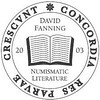 David F. Fanning Numismatic Literature has released its latest fixed price catalogue. This is an Internet-only listing, available for downloading from the www.fanningbooks.com Web site. The list includes numismatic literature from around the world and in many different languages, and features a number of sale items and reduced prices. To download the catalogue, simply go to
www.fanningbooks.com
.
David F. Fanning Numismatic Literature has released its latest fixed price catalogue. This is an Internet-only listing, available for downloading from the www.fanningbooks.com Web site. The list includes numismatic literature from around the world and in many different languages, and features a number of sale items and reduced prices. To download the catalogue, simply go to
www.fanningbooks.com
.
David Fanning can be reached at (614) 256-8915 or by e-mail at dfanning@columbus.rr.com .
SKLOW NUMISMATIC LITERATURE MAIL BID SALE #9 CLOSES FEBRUARY 13, 2010
 MBS # 9 of Numismatic Literature will close Saturday February 13, 2010 at 8PM MT. Bidding is accepted via: Phone 719-302-5686, FAX: 719-302-4933, EMAIL: numismaticbooks@aol.com and USPS at P.O. Box 6321 Colorado Springs, CO. 80934.
MBS # 9 of Numismatic Literature will close Saturday February 13, 2010 at 8PM MT. Bidding is accepted via: Phone 719-302-5686, FAX: 719-302-4933, EMAIL: numismaticbooks@aol.com and USPS at P.O. Box 6321 Colorado Springs, CO. 80934.
NEW BOOK: STRIKING GOLD IN ALASKA BY DICK HANSCOM
The Press Release reads as follows:
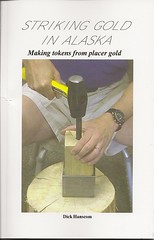 Alaska Rare Coins is pleased to announce the publication of Dick Hanscom's new book "Striking Gold in Alaska, Making tokens from placer gold."
Alaska Rare Coins is pleased to announce the publication of Dick Hanscom's new book "Striking Gold in Alaska, Making tokens from placer gold."
This 60 page book (8 1/4 inches by 5 3/8 inches) is fully illustrated in black and white, with color covers. It follows the process from purchasing the gold, preparing the gold for striking, engraving the dies, and striking. Formulas are given for fluxes, specific gravity, and determining the size of the tokens. Sources of supplies and equipment are listed.
The price is $12 postpaid from Alaska Rare Coins, P.O. Box 72832, Fairbanks, AK 99707.
From the book's back cover:
Rather than do something constructive, Dick Hanscom has been making gold tokens from Alaska placer gold since 2005. Sadly, he has no artistic talent, few metal working skills, and should not be trusted with anything more technologically advanced than a hammer. Fortunately, a 3 pound hammer is all it takes for most of his tokens.
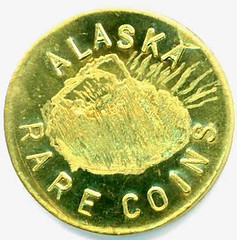
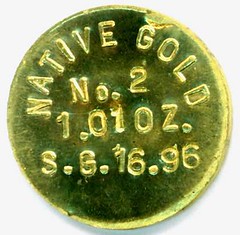
It's a well-illustrated book, with about one black and white photo per page. You couldn't ask for a better how-to guide. It's arranged in three main sections: Making Planchets, Making the Dies, and Striking. An Appendix lists formulas for flux components, measuring specific gravity, and estimating the fineness and dimensions of the gold tokens. Also included are tables of the sizes and characteristics of the gold tokens.
Here are some excerpts.
It all began in 1990. I was at the ANA convention in Seattle. There was a burly Fijian sitting behind a log, hand striking 1/20 ounce gold tokens. This was the Pacific Sovereign Mint's exhibit promoting a new bullion coin series. The coins were struck from unrefined Fijian gold. The purity was touted as 75% to 84% with a minimum of 75%. This series, while interesting, did not fulfill the requirements of bullion coinage. It lasted three years.
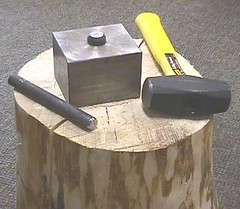 After seeing this, I mentioned to my father that this was something I might like to do. We "designed" the necessary equipment: an anvil to hold the lower die, the lower die and the upper die. The lower die and opening in the anvil are tapered. This allows it to seat firmly in the anvil, yet be easily removed. All I had to do was have the dies cut.
After seeing this, I mentioned to my father that this was something I might like to do. We "designed" the necessary equipment: an anvil to hold the lower die, the lower die and the upper die. The lower die and opening in the anvil are tapered. This allows it to seat firmly in the anvil, yet be easily removed. All I had to do was have the dies cut.
Enter years of procrastination.
In 2005, I looked for another die cutter and I remembered Charles Arceneaux. He had struck pewter tokens for my wife's basketball team in 1981. I found Charles and got in touch with him. Sure, we can have the dies done by May 21 (to give a little breathing room for my actual required date of June 21)! And we were well on our way. The upper die was smoothed off and roughly cut. Then, I received an email from Charles with "Panic" in the subject line. The lower die had been hardened and could not be engraved. I have very little knowledge of such things, but seemed to remember something about heating to soften steel. Charles looked into it. He had access to a kiln and was able to anneal the die to soften it. Because of the annealing problem, we missed my June 21 deadline, but darn, we were close. The dies arrived about July 1. Now it was up to me to process the gold and strike the tokens.
I use raw, unrefined Alaska placer gold. Estimated fineness is .750 to .850, and some is even higher. To prepare the gold for striking, it must be melted with an oxygen/propane torch in a ceramic crucible. Acetylene is not recommended.
Then, it is poured into an ingot mold. After cooling by dropping it into a bucket of water, the ingot is removed and rolled in the rolling mill to a thickness of .65mm. Using a disk cutter to cut a 14mm blank, this thickness gives a weight of just over 1 DWT (1/20 ounce). The mold is shown with gold in the bottom and slag adhering to both sides of the mold on the previous page.
Striking is a simple process. The blank is carefully centered on the lower die. A guide (a wooden block with a hole drilled to accept the upper die) is placed over the lower die, and the upper die is carefully inserted in the guide. This guide keeps the dies properly aligned during striking. It also gives me a place to hold onto the upper die while I am hitting it with a three pound hammer. I prefer to keep my hand out of the way! I was soon minting 1 DWT tokens. My first three experimental/presentation pieces were made with unattributed gold.
Dick's a regular E-Sylum contributor. Many thanks for providing the images and text for this article. The book is a great record of the creation of these interesting pieces. It's a shame that over the years more private minters haven't set their stories to paper - how much more we would know about them and their work, which is all too often shrouded in obscurity.
NEW CD BOOK: CHATTANOOGA MONEY BY DENNIS SCHAFLUETZEL
 It may look like oversized Monopoly money with "Chattanooga" printed on it, but the bills are the real thing, and they're almost 150 years old.
It may look like oversized Monopoly money with "Chattanooga" printed on it, but the bills are the real thing, and they're almost 150 years old.
What's more, "Chattanooga" money was quite common in its time.
"The only paper money in the United States (at that time) was issued by maybe 10,000 banks that put out their own individual money," said Dennis Schafluetzel, a Chattanooga coin collector who has researched local money.
In researching the bank notes, Mr. Schafluetzel and his researching and writing partner, Chattanooga coin collector Tom Carson, have published an e-book on CD, showing all the known varieties of Chattanooga money. In the process, the two have become known as the country's recognized experts on Chattanooga and Tennessee money.
Jim Ogden, Chickamauga and Chattanooga National Military Park historian, said the little-known money -- and similar currencies from banks and organizations in Northwest Georgia -- helps reflect how complex the era was.
"We have a tendency to simplify the time and romanticize it," he said. "But if you were on the street with a fistful of this currency (from one bank or another) you might think you had $25, but maybe you didn't."
Just before the Civil War, the country was in recession, Mr. Ogden said, but the Chattanooga area, growing fast because of the railroads, had new banks and businesses springing up.
The most common North Georgia currencies came from Western Atlanta Railroad, which was owned by the state of Georgia and had its northern terminus in Chattanooga, he said. There also were a number of currencies from banks in Rome, then the largest and fastest-growing city in the region.
"There's a lot still to learn," Mr. Ogden said of the Chattanooga, Tennessee and North Georgia currencies. "For some of these currencies, we don't know a lot about the organizations that issued them or the people behind them."
Ken Rentzsch, of Hixson, is a member of the Chattanooga Civil War Roundtable, a club where Mr. Carson and Mr. Schafluetzel recently made a presentation about the currency and their collection. He said he was fascinated to learn about the "Chattanooga" money.
"It's just amazing," he said. "I had no idea that this happened here."
To order the book, see: www.schafluetzel.org
To read the complete article, see: Cashing in on history's dollars (www.timesfreepress.com/news/2010/jan/26/cashing-in-on-historys-dollars/?local)
THE BOOK BAZARRE
BOOK REVIEW: STRIKE IT RICH WITH POCKET CHANGE, SECOND EDITION
 If I'm correct, most of the folks reading this article began collecting coins in the early sixties or early seventies. In those years you could still find many wheat back cents in circulation and every once in a while a silver coin would turn up in loose change. Those were the days of mail order stamps and coins. Baseball cards were attached to bicycle spokes and Willie Mays would be ripped to shreds in about two city blocks. Yeoman's Red Book was about the only coin book on the planet. At least as far as anyone on our street knew, and what R.S. said was written in stone.
If I'm correct, most of the folks reading this article began collecting coins in the early sixties or early seventies. In those years you could still find many wheat back cents in circulation and every once in a while a silver coin would turn up in loose change. Those were the days of mail order stamps and coins. Baseball cards were attached to bicycle spokes and Willie Mays would be ripped to shreds in about two city blocks. Yeoman's Red Book was about the only coin book on the planet. At least as far as anyone on our street knew, and what R.S. said was written in stone.
It took me a long while to put my first Lincoln cent collection together. I lived in the east where S-mint pennies are next to impossible to come by, and the coin shop was two hours by Schwinn. Fortunately, there were the cousins in California and we would trade through our Grandfather who traveled in the winter to see them, and in the summer to see us.
When I was about thirteen this girl became very interesting and the coin collection was put away. There was baseball, and girls, then later still cars and other responsibilities. Eventually I came back to collecting and to the Lincoln cent as I think most of us will do. It seems that folks always return to what they love, and upon returning I found a whole new ball game, as maybe you did too.
I learned terms like doubled die, repunched mintmark, reverse counter clash, and some foreign language called brockage, which I thought was some kind of intestinal disorder. It was a pleasure to discover varieties having completed the regular Lincoln cent series. I was told there are thousands of varieties of the Lincoln cent and other coins, hundreds for some of the years. So being the curious collector I decided to study up on these interesting anomalies. In my collection a small number of coins had been set aside in 2x2's with question marks penned on the outside. It was time to finally do some serious research on these coins.
Having asked around, I was turned on to Strike It Rich with Pocket Change by Brian Allen and Ken Potter. This was a great decision because one of the coins with a question mark turned out to be a 1969-S counter clash. It was worth a couple hundred dollars. This coin was very hard to nail down and the only place I could find any definitive information was in Strike it Rich with Pocket Change.
Having obtained the book, I found many more examples of strange and unique coins that had been set aside years ago. In the old Whitman folder a 1968-D doubled die reverse had been lying in wait for years. I always wondered how the United Sates mint could make so many mistakes but never really thought they would become highly prized specimens.
Most folks are unaware of what they carry in their pockets, and even then, when they learn it, are mystified that a coin could earn them more of a return than stock in Johnson & Johnson! Think about it - one cent into two hundred dollars is an increase of 20,000%. If anyone can tell me where you can get that kind of a return I will invest straight away. I will thank you all the way to the bank.
There is a copper, nickel, and zinc mine in the free flow of our nation's currency and Allen and Potter have gone in and cleared away the brush. They have put a plan together complete with hundreds of black and white photographs which may lead you in the direction of that mine. The instructions are clear with arrows which show you how to determine which of the rocks is a gem.
It is not simple though, and mining is not easy; if it were, everyone would have a Hummel. It would be very pretty, but nevertheless an over produced product that nobody wants. Allen and Potter have weeded out and narrowed it down to those coins that are unique and obtainable. Strike it Rich discusses methods, and details most of the varieties and errors that you or I would find in our pockets. They don't waste your time with unobtainable coins.
It is also true that not all coins with strange markings or designs are valuable. Allen and Potter discuss ways for you to avoid those pitfalls and educate you in ways to look for more information on the topic. In the back of this volume are appendices which lead you further in your journey - you will find there are more gems yet to be discovered. This is the real fun of the hobby of coin collecting.
Allen and Potter's Strike it Rich with Pocket Change does have a complete and up to date price guide but it does not have a totally up to date price guide. What is this nonsensical statement, you may ask yourself? Well I can answer by saying what the writers intended and what all numismatists should understand, a guide is a guide and all coins that are sold are subject to free market conditions. Which in a nutshell means a coin will only sell at what the market will bear. Besides, there is a lag time between when a book is written, when it actually goes to print and then ends up at Amazon. This I do know from experience and you will find this out upon discovering a coin in the book and looking up its price; and when you try and sell it on eBay. The coin may only realize about fifty percent of its book value, no one knows for sure. Exasperating yes; but still a very tidy profit if that is what you are after.
Strike it Rich with Pocket Change, Second Edition will take you on a journey into the world of variety and error collecting, it will explain the die making process without a need for a degree in metallurgy. The chapter on the various types of coin doubling is well worth the read. Perhaps intended for the beginner this book will prove over time to be a savior to the seasoned collector. How many times have you the collector found a strange looking coin…and wondered what it's worth, if anything? Immediately you think of the other books available. But then it becomes apparent that most standard coin guides do not have the information you seek.
This book is the perfect antidote for those issues not covered by the other volumes. Strike it Rich with Pocket Change is aptly named; most of us numismatists know that striking it rich is a little more difficult than it sounds. But money can be made and the art of coin collecting will be educational and entertaining, and that is the value for me. If you are interested in varieties, have a collection already and would like to see if that one coin you possess is in fact an error coin, then Strike It Rich with Pocket Change, Second Edition is your book.
Strike it Rich is to-the-point and will explain in general terms the basic terminology of variety and error coin collecting while dispelling some of the myths that surround the hobby. The coins which are represented in the volume are those which you would expect to actually find in pocket change or at your local financial institution, coins which do have collectible value above and beyond their intrinsic worth.
Ever since J.N.T. Levick published a price survey of United States large cents in 1868, dealers and collectors have been trying to wrestle with the historical importance of a coin versus its value, with value in the form of price lists winning the fight each and every time. Allen and Potter have produced this updated second edition of Strike it Rich with Pocket Change to meet those demands and also to meet the continuing demands of the coin error and variety collector. Well for my two cents I think they have done an outstanding job.
Strike it Rich with Pocket Change, Second Edition is written by Brian Allen and Ken Potter; it is published by Krause Publications, a subsidiary of F + W Media, Inc and can be found at http://koinpro.tripod.com/bookofmonth.htm and your local retailer.
To read the original publisher's press release, see: Strike It Rich With Pocket Change, Second Edition Now Available (www.prlog.org/10201352-strike-it-rich-with-pocket-change-second-edition-now-available.html)
ORDERING THE NEW YORK NUMISMATIC CLUB CENTENNIAL HISTORY
New York Numismatic Club President Jerome C. Haggerty writes:
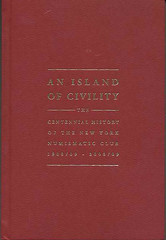 I was delighted to see George Cuhaj's piece concerning the New York
Numismatic Club's history and centennial medal. The books are available by
mail directly from the Club.
They have been well received, and in fact I am bringing a few copies to Ireland next month for the meeting of the Numismatic Society of Ireland and the Dublin coin show.
I was delighted to see George Cuhaj's piece concerning the New York
Numismatic Club's history and centennial medal. The books are available by
mail directly from the Club.
They have been well received, and in fact I am bringing a few copies to Ireland next month for the meeting of the Numismatic Society of Ireland and the Dublin coin show.
The book is 437 pages, 6' x 9' format, hardcover, loaded with photographs (including every NYNC Presidential Medal) and was limited to 150 copies. The price is $125 + $10 for postage. Make checks out to the New York Numismatic Club. The book may be ordered by mail from:
NYNC
c/o JEROME HAGGERTY
408 ATLANTIC AVENUE
BROOKLYN, NY 11217-1704
email: brooklyn.gator@verizon.net


The Centennial medals are sold out. They were issued as bronze singles or silver and bronze sets with matched numbers. Struck by Medalcraft Mint of Green Bay, Wisconsin, the strike was limited to 70 pieces, 27 of which were silver, the remaining 47 in bronze. The silver/bronze matched set available was priced at $450. The medals are 2.5" in diameter, the bronze weighs 4.25 oz., the silver (approx.) 5.0 oz.
Dick Johnson writes:
That's a fantastic medal by Eugene Daub. It's quite interesting with three prominent numismatists portrayed on it. I often sat next to one of those portrayed when I attended NYNC meetings. QUIZ QUESTION: guess which one. [Hint: I'm not that old!]
To read the earlier E-Sylum article, see: NEW YORK NUMISMATIC CLUB CENTENNIAL HISTORY PUBLISHED (www.coinbooks.org/esylum_v13n04a06.html)
ANS LIBRARY CATALOG NAMING CONTEST DEADLINE FEBRUARY 15, 2010
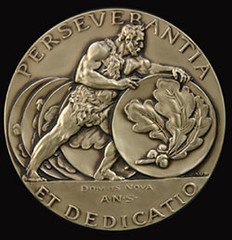 In 2010, the ANS Library will launch a new and improved library catalog.
This catalog needs a name. I would like to ask for the creative minds of the numismatic community to help with this, and so I am initiating a contest for the best name of our new catalog. The person who submits the name that is chosen will win a $100 ANS gift certificate, which can be used for a wide variety of ANS purchases, including publications, library services, membership, and more!
In 2010, the ANS Library will launch a new and improved library catalog.
This catalog needs a name. I would like to ask for the creative minds of the numismatic community to help with this, and so I am initiating a contest for the best name of our new catalog. The person who submits the name that is chosen will win a $100 ANS gift certificate, which can be used for a wide variety of ANS purchases, including publications, library services, membership, and more!
The contest deadline is February 15, 2010, so make sure to get your ideas in before then! To submit your entry, please email the contest address ( contest at numismatics.org ) or mail your entry to "Attn: Library Contest" at the ANS headquarters in New York City. You can submit as many entries as you like. No phone calls please, as submissions must be made in writing.
For examples of other names and possible inspiration, you might look at what other libraries have done, such as BobCat (NYU library), Corsair (Morgan Library and Museum), Ambrosia (Blegen Library), etc. We are looking for something short and sweet but creative, with obvious relevance to the ANS collections.
FOOD STAMPS AS MONEY
Tom DeLorey writes:
 Food stamps are indeed a form of American money. Back in 1972 I was working my way through college at the Home Juice Co. in Detroit, taking deposits from route drivers which included regular currency, coin and quite a large number of food stamps.
Food stamps are indeed a form of American money. Back in 1972 I was working my way through college at the Home Juice Co. in Detroit, taking deposits from route drivers which included regular currency, coin and quite a large number of food stamps.
The drivers hated them because they were always new, and tended to stick together just like regular new currency does. Also, they had to rubber stamp each one with a deposit stamp.
As I had to count them again from all 42 drivers I hated them all the more, but recognize them as being a part of the American numismatic realm.
The Food Stamp program is a joint Federal-State program to improve nutritional standards for America's low-income families and individuals. It began in 1961 with pilot programs in seven rural areas and one city, Detroit, based on the experience of the 1939-1943 surplus food distribution plan of the Federal Surplus Commodities Corporation and its successor agencies. The success of the pilot programs in improving the quality and quantity of the participants' diets and in expanding markets for livestock products, fruits and vegetables led to passage of the Food Stamp Act (Public Law 88-525) which was signed into law on August 31, 1964. Today, the program operates nationwide.
Eligible households participate in the program by purchasing an allotment of food stamps. The amount they pay (ranging from zero to a maximum of 30% of their net monthly income) is based on income and family size. Initially, the households received books of paper coupons in various denominations, which they redeemed at participating food stores for authorized food purchases. The food stores deposited the collected coupons in their bank accounts for credit, endorsing them on back. The banks handled the coupons like checks, clearing them through the various Federal Reserve banks. More recently, the food stamp benefits have been provided to participants by "paperless" electronic benefits transfer (EBT) cards, which are used like debit cards, the merchant deducting the amount of the purchase directly from the participant's food stamp account.
The Food Stamp program had an exonumic side. Until January 1, 1979, retail grocers gave change for the coupons in paper scrip or plastic tokens. Thereafter, merchants were required to make change in U. S. coins, and the food stamp change tokens and scrip went out of use. Collectors beat the bushes to find and assemble sets of the tokens and scrip before they disappeared altogether. A leader in this field of exonumia was Jerry F. Schimmel, of San Francisco, who published the Food Stamp Change Newsletter from 1980 to 1984. It circulated to a coterie of a few hundred exonumists. Our editor, Gary Patterson, published listings of New Jersey's food stamp tokens in Schimmel's newsletter and in the TAMS Journal.
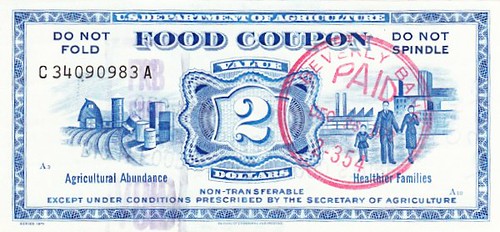
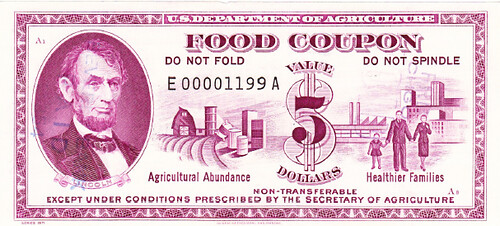
Shown here are two canceled food stamp coupons of the "series 1971" with the imprint of the Bureau of Engraving and Printing.
To read the earlier E-Sylum article, see: SMITHSONIAN ACQUIRES USDA FOOD STAMP ARCHIVE (www.coinbooks.org/esylum_v13n04a14.html)
MORE ON THE SPENDING PSYCHOLOGY OF MONEY DENOMINATIONS
Darryl Atchison writes:
First of all, congratulations on another excellent edition - as usual a good mix of subjects. I found the article on spending habits interesting and thought I would inject my own experience into the conversation.
In the past few years (here in Ireland), patrons using our ATMs have been forced to withdraw ONLY €50 notes on many occasions - a phenomenon which happens more often than not it seems these days. If you request a withdrawal of €80 the machine will take you through the entire process until it comes to time to dispense the notes. Then you get a message along the lines that the machine won't let you withdraw an amount that is not a multiple of €50. As a result, you end with only large bills in your wallet.
No doubt, many people do what I do - which is to get rid of the €50 note as soon as possible since many businesses won't accept them due to high rate of counterfeit notes in circulation. No longer are my spending habits dictated by my needs or vice versa... the need to have small bills often forces me to buy small items (newspapers, chewing gum, etc.) just to get smaller notes sooner rather than later.
I don't know if the same is true on your side of the world. However, the dispensing of only €50 notes is unquestionably a huge inconvenience for the bank's clients although no one ever seems to complain openly about it.
To read the complete article, see: THE SPENDING PSYCHOLOGY OF COIN AND PAPER MONEY DENOMINATIONS (www.coinbooks.org/esylum_v13n04a16.html)
QUERY: SPANISH-AMERICAN EIGHT REALES METROLOGICAL DATA SOUGHT
Chris Faulkner writes:
I was wondering if anyone could direct me toward a source in answer to the following problem. I'm looking for a source that provides full and accurate metrological data on Spanish-American bust 8 reales from 1772 to about 1820. The mints that I'm interested in are Mexico City, Lima and Potosi.
I'm after changes in silver fineness, weights, diameters, and thicknesses over those years for each of those mints. One would think such information would be relatively easy to find, but the data is often inconsistent or unreliable, and diameters and thicknesses especially are missing altogether.
THE BOOK BAZARRE
MORE ON CENTRAL INTELLIGENCE AGENCY MEDALS
Matthew R writes:
I stumbled onto your website doing a search on Google. I saw an article about CIA medals. In answer to your question, yes, they do pop up on eBay. I have a collection of about eight different CIA medals. As for giving the medal back, I don't believe that to be true. I know a couple of people that got awarded medals for certain acts of "heroism" and they display them proudly in their home, with the certificate that accompanies it.
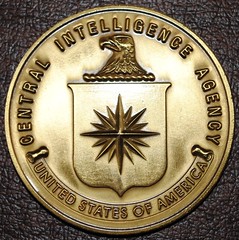
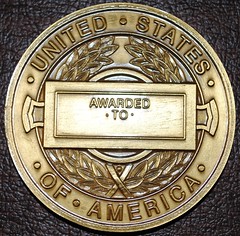
To read the earlier E-Sylum article, see: CENTRAL INTELLIGENCE AGENCY MEDALS (www.coinbooks.org/esylum_v13n02a16.html)
COINTELEVISION.COM COVERS THE 2010 F.U.N. SHOW
David Lisot forwarded this press release about the latest videos on his CoinTelevision web site:
New free video clips have been posted on Cointelevision.com from the FUN Coin Convention held in Orlando.
Segments include the sale of the 1913 nickel, the FUN opening ceremony, comments from FUN President Bob Hurst, FUN Convention Coordinator Cindy Wibker, FUN Convention volunteers, Silvano DiGenova of Tangible Investments, Scott Schechter of NGC, Brian Kendrella of Teletrade, Jim Pappas of JP Coins, David Hunt of Certified Asset Management, Bill Pearson of Forcastle Treasures, Scott Purvis, Founder of CoinLink.com, and the wizard "RAZZI"! (Wayne Herndon of Wizard Coin Supplies.
To visit the CoinTelevision home page, see: http://cointelevision.com
THE BOOK BAZARRE
CANADIAN COLLECTOR'S COINS TELL A STORY
Here is an article in the Regina Canada Leader-Post that tells one of the most significant -- and charming! -- stories of a coin collector's personal saga with his collection. My hat is off to coin collector Jim Smalley, a member of the Regina Coin Club, who learns the story behind his coins and enjoys the pleasure they bring to him.
Smalley's collection covers a lot of history, from ancient coins to the second world war. He likes unusual coins, "oddballs" he calls them. By "oddball" he means a collection that includes ancient and medieval coins, early Roman Empire, those from the British Empire (places like Australia, British Honduras and Belize), wartime occupation, and from what he calls "dead countries" -- that no longer exist -- as well as obscure places, like Iceland and Tasmania. There are even oddities among his oddballs -- like the token of Ghandi with the slogan "Superman."
A small silver coin with a ship and the word "Ant" conjures up memories of high school classes on Shakespeare's Julius Caesar. The "Ant" is for Antony -- Caesar's right-hand man Mark Antony. "To take his troops (to battle), Mark Antony went to Cleopatra and said 'I need some money, I need silver.' And that's a piece of Cleopatra's silver, to pay Mark Antony's troops."
A nice sixpence recalls the Tudors, and King Edward VI's brief reign after the death of his father, Henry VIII. What Smalley really wants is a reasonably priced Bloody Mary -- the nickname given to Queen Mary, Henry VIII's daughter by his first wife.
I even like the story where Smalley saved up 10 kilos of British coins, flew to London with his wife, and spent the coins during a six-day visit, counting out 50- and 20-pence coins for each purchase.
This is a charming account of coin collecting as it should be, unprecedented discoveries, determined research, and the pleasure of the knowledge of the tales your coins can tell.
You can share that symbiotic pleasure by just reading this collector's account.
Amazing -- it's a word that comes up quite often when you spend a bit of time with Smalley, his coin collection and his equally impressive memory for history.
While many collectors long for such rarities as a 1936 Canadian dot penny -- which recently sold for $400,000 at a U.S. auction -- Smalley's tastes aren't nearly as expensive. His focus is as unique as his coins. "I collect the oddball stuff," he says.
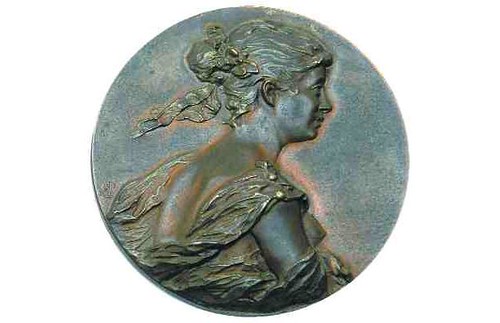
Like a proud father opening up his wallet to show off pictures of his children, Smalley holds up one of the most artistic and beautiful pieces in his collection. The bronze medallion has the raised impression of a young woman, ribbons flowing from her hair. "You won't believe it under glass," says Smalley excitedly. "What's so unusual about it is you would not know who it was. There's no writing. There's not even an engraver's initial."
However, Smalley's pretty confident it depicts Napoleon Bonaparte's second wife Marie Louise because of the two medals that accompanied it -- one showing the church in Strasbourg, France, where Napoleon married his Austrian bride by proxy in 1810, and the other of Napoleon and Marie Louise, whom Smalley believes is the same as the woman on the bronze disc.
"I consider this very enigmatic," says Smalley, explaining that he has been unable to find any information on the medallion -- a sort of billboard of its day, announcing Napoleon's marriage.
To read the complete article, see: Every Coin tells a Story (www.leaderpost.com/health/Every+Coin+tells+Story/2503046/story.html)
HIGH QUALITY COUNTERFEIT BANKNOTES FOUND IN JAPAN
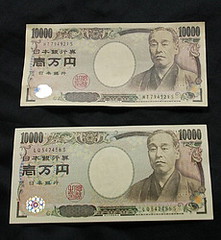 Some 60 counterfeit bills have been found in four prefectures in Tohoku this week, it has been learned.
Some 60 counterfeit bills have been found in four prefectures in Tohoku this week, it has been learned.
The high-quality fake 10,000 yen bills turned up in Aomori, Iwate, Miyagi and Fukushima prefectures between Monday and Friday. They were slightly redder than normal bills and had no watermarks. However, an expert says the quality could indicate the involvement of professional counterfeiters.
"It's hard to tell the difference. I realized the bill was a fake only after I checked the watermark," said the 65-year-old owner of a liquor shop.
"The holograms printed on the fake bills are sophisticated," said Tomohiko Endo, chief of the Counterfeit Currency Detection Research. Endo pointed out that the fake bills may have been produced using a color printer without an anti-counterfeiting function, which went on sale before 2005.
To read the complete article, see: High quality counterfeit banknotes found in Tohoku (mdn.mainichi.jp/mdnnews/news/20100130p2a00m0na006000c.html)
VERDICT IN BINION CASINO MURDER CASE
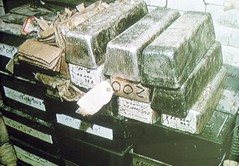 Rick Tabish, once convicted and later acquitted of the murder of Las Vegas casino figure Ted Binion, has been granted parole.
Rick Tabish, once convicted and later acquitted of the murder of Las Vegas casino figure Ted Binion, has been granted parole.
Tabish and his girlfriend, Sandra Murphy, were convicted of drugging and then suffocating Binion, a son of Las Vegas gambling pioneer Benny Binion. Following the highly publicized trial, Tabish received a 25-year to life term and Murphy got a 22-year to life sentence.
The Nevada Supreme Court in 2003 ordered a new trial. And at the second trial they were acquitted of the murder charges but convicted of grand larceny and burglary in connection with the removal of Binion's silver fortune from a vault in the desert near Pahrump.
Binion was found dead in his Las Vegas home in September 1998. Authorities first said it was an apparent suicide from a drug overdose, but later reversed course and charged Tabish and Murphy with his murder. The prosecution contended the two had drugged Binion and then strangled him.
Binion, according to authorities, had a drug problem and in 1996 was banned from entering the family's casino, Binion's Horseshoe. His state gaming license had been revoked.
He built a deep vault in the desert floor west of Las Vegas to store silver. There were reportedly six tons of silver bullion, casino chips, paper currency and more than 100,000 rare coins.
Binion hooked up with Murphy, a topless club dancer who became his live-in girlfriend. But she got close to Tabish and authorities accused them of planning the death and robbery.
To read the complete article, see: Rick Tabish granted parole in Ted Binion case (www.lasvegassun.com/news/2010/jan/27/rick-tabish-granted-parole/)
OLDEST ROMAN COIN EVER FOUND IN BRITAIN
A 2,221-year-old silver coin dug up as part of a hoard is the oldest piece of Roman money ever found in Britain. Dating from 211 BC and found near the Leicestershire village of Hallaton, the coin was uncovered with 5,000 other coins, a helmet and a decorated bowl.
Unearthed in 2000 by a metal detectorist, staff at the nearby Harborough Museum have only just realised its significance.
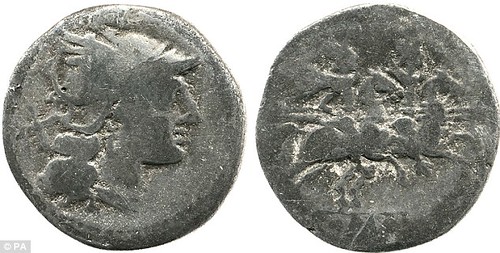
One side of the coin depicts the goddess Roma wearing her characteristic helmet while mythical twins Castor and Pollux sit astride galloping horses on the reverse.
David Sprason, Leicestershire County Council cabinet member for communities and well-being said: 'Leicestershire boasts the largest number of Iron Age coins ever professionally excavated in Britain.
'To also have the oldest Roman coin ever found is something very special.' The type of coin, known as a denarius, was first struck in Rome in 211 BC, making the Hallaton coin a very early version, the council said.
A soldier or unskilled worker living in the first century AD could expect to earn one denarius for a day's work. The previous oldest known Roman coin found in Britain was discovered by a metal detectorist in Berkshire last year.
Professor David Mattingly of the University of Leicester's School of Archaeology and Ancient History described the news as 'exciting'.
He said: 'This hoard has changed our view of just how significant the East Midlands were in this period and this coin is a good example.' 'It indicates there was contact between this region and the Roman Empire despite the distance between the East Midlands and the parts of Britain the Romans arrived in, like Colchester and Chichester.'
The coin would have passed through many hands, he added.
'It was minted in Rome at the time of the Hannibalic wars and here it is turning up after what must have been quite a long journey,' he said.
To read the complete article, see: Silver coin dating to 211 BC is oldest piece of Roman money ever found in Britain (www.dailymail.co.uk/news/article-1247092/Silver-coin-dating-211BC-oldest-piece-Roman-money-Britain.html)
COINS RECOVERED FROM 1890 TURKISH SHIPWRECK NEAR JAPAN
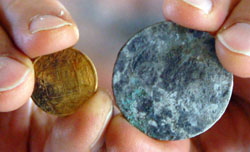 A Japanese-Turkish research team announced Monday the discovery of a British-minted gold coin and a Japanese silver coin from a Turkish warship that sank 120 years ago off Kushimoto, Wakayama Prefecture.
A Japanese-Turkish research team announced Monday the discovery of a British-minted gold coin and a Japanese silver coin from a Turkish warship that sank 120 years ago off Kushimoto, Wakayama Prefecture.
"Still there should be lots of gold coins" inside the ship Ertugrul, said Tufan Turanli, who heads the underwater archaeological team.
The gold coin, dated 1856, measures 2.2 cm in diameter and weighs 8 grams.
Ertugrul, a 76-meter wooden ship of the Ottoman Turks, sank in a typhoon in 1890 after the Turkish delegation on board delivered a message and decoration to Emperor Meiji.
Of the 650 crew members, 69 were rescued by local residents. The rescue has become a symbol of Japan-Turkey friendship. survey in 2008, has already discovered about 5,800 items from the wreck.
To read the complete article, see: Team finds lost U.K., Japan coins (search.japantimes.co.jp/cgi-bin/nn20100126a3.html)
THE ZERO RUPEE BRIBERY NOTE
Loren Gatch writes:
The links below describes a distinctive protest movement in India against the omnipresent nuisance of bribery: the use of the "zero rupee" note. Paid to grasping public officials instead of genuine money, the zero rupee note symbolizes the fight against bureaucratic corruption and dishonesty. The movement has been active for a couple of years
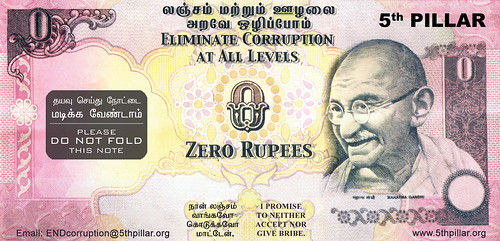
In the secret language of corruption in India, an official expecting a bribe will ask for Mahatma Gandhi to "smile" at him. The revered leader of the independence movement is on all denominations of rupee notes.
With rampant dishonesty ingrained in the bureaucratic culture, an anticorruption group has decided to interpret the euphemism literally by issuing a zero-rupee note.
A direct copy of the 50-rupee note, including Gandhi's portrait, it is designed to be handed out to officials who demand backhanders.
In the place of the usual promise of redemption by the central bank governor, the new pledge is: "I promise to neither accept nor give bribe."
5th Pillar, the organisation behind the initiative, says that the note will allow ordinary Indians to make a statement against corruption without provoking a confrontation with people in authority.
It has printed 25,000 notes and is distributing them in the southern city of Chennai as part of a wider mission to stamp out corruption "at all levels of society".
Corruption is part of the daily routine in India. Whether an individual needs to get a phone line, renew a passport or dodge a speeding ticket, the process normally involves a bribe. Most officials get away with it because of a general lack of awareness about citizens' rights.
To read the complete article, see: Can this note stamp out corruption in a land where it's the norm? (www.timesonline.co.uk/tol/news/world/asia/article1629446.ece)
To read another article, see: Paying Zero for Public Services (blogs.worldbank.org/publicsphere/paying-zero-public-services)
FEATURED WEB SITE: THE HAÏTIAN NUMISMATIC SOCIETY
This week's Featured Web site is the Haïtian Numismatic Society. I tried the email links and they all bounce. I'm not sure how recently the site was updated, but I'm curious to learn the fate of numismatists and numismatic collections following the recent earthquake disaster in Haiti.

Haïti's colorful history is proudly reflected in numismatics, both in coins and banknotes, with one of the most vivid examples being the newly released 2004 bicentennial series of banknotes. Haïti numismatics has long had a small but very dedicated collector base within Haïti who have not had a specialized organization dedicated to their needs. With the establishment of this new organization we hope to bring greater awareness of Haïtian coins, medals and banknotes not only to Haïtians but to a wider audience throughout the world.
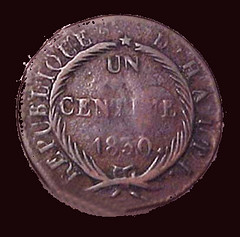
http://numismondo.net/hns/
